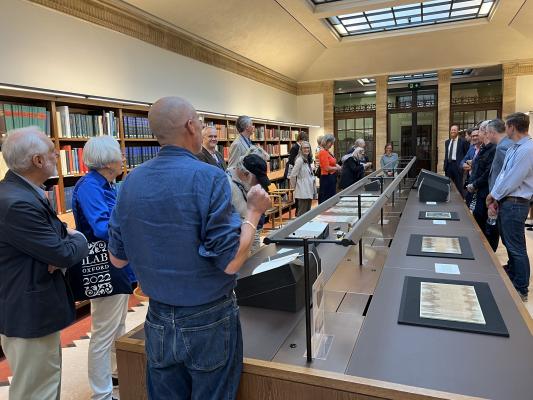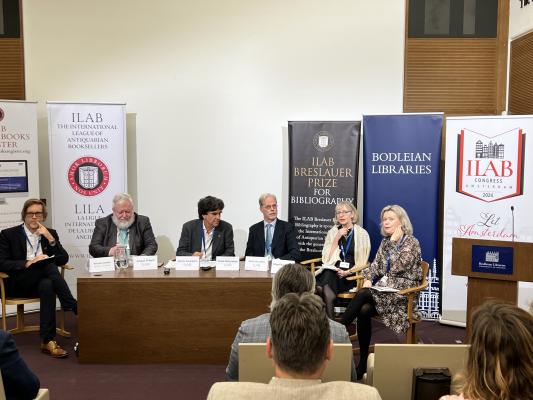Actualités
The ILAB Congress 2022 in Oxford - Day 2

Text by Anna Middleton, Images Angelika Elstner
Perhaps the biggest attraction of Oxford for bibliophiles is the Bodleian Library. Of the 13 million items held by the Bodleian, over one million can be categorized as "special collections", and the librarians shared with us a genuinely extraordinary selection of the very best. Three concurrent private exhibitions were run for ILAB in carousel at the Weston Library, home to the special collections, alongside an architectural and historical tour.
The Bodleian's best-known treasures were centre stage, and their fame did not diminish the excitement they engendered. Attendees made a beeline for the only known copy of the first of Shakespeare's works to be printed (Venus and Adonis, 1593); Mary Shelley's manuscript draft of Frankenstein, written in Geneva; Jane Austen's first extant draft of The Watsons, one of the earliest examples of an English novel to survive in its formative state; The Bay Psalm Book, the most expensive book in the world; and Kafka's manuscript of Die Verwandlung (Metamorphosis). The sheer size of the Bodleian's collection makes an exhaustive exhibition impossible: instead, attendees were given a magnificently comprehensive cross-section of the library's treasures.
The headline items were displayed alongside unanticipated new acquisitions, rediscoveries, and freshly restored items: a beautiful example of Persian calligraphy from the Shah Jahan period (1628-1658), a rare complete copy of the Qur'an in neo-Kufic, and Alan Bennet's box of mantelpiece oddities (a challenge for conservators with chocolate, cigarettes, and Simpsons figurines). There were Sappho fragments from the second century AD; the oldest book entirely in the English language; the Hawara Homer; a bead-embroidered Qur'an; maps, manuscripts, school pieces, musical scores, original artwork; Speed's Oxfordshire Described, the Wind in the Willows letters, the "Ormulum" - this list is very far from exhaustive, and every item omitted for the sake of brevity is of comparable significance. It was a full day of books, bindings, manuscript, ephemera, and most notably, the expertise and generosity of the Bodleian's specialists. Richard Ovenden and Dr Christopher Fletcher were accompanied by colleagues who shared their research, insight, and delight at the treasures on show.
Dinner was no less impressive an affair. The architectural tour had already introduced us to our venue: below the Duke Humfrey's Library (also opened for ILAB) is the medieval Divinity School. It is the oldest surviving purpose-built building for university use, employed that evening for our fittingly atmospheric end to an almost overwhelmingly rich day.
























































